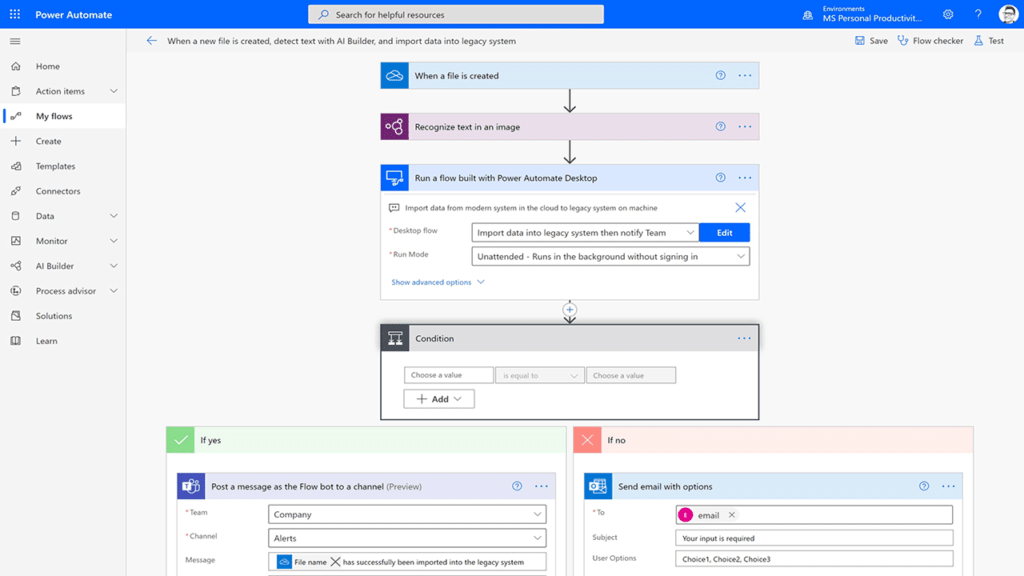
Power Automate from Microsoft is benefiting businesses across the world including many of our customers. But to explain how, first we’ll discuss what it actually is, along with some real life examples to put the benefits of Power Automate into context for you.
What is Power Automate?
Formerly known as Microsoft Flow, Power Automate is a Microsoft 365 application that allows businesses to create automated workflows, file management and data collection. This allows businesses to streamline their day to day by having Power Automate automatically carry out tasks that staff members would’ve previously been responsible for. For example, automatically placing certain documents in specific folders based on set criteria, or automatically sending quotes for approval to relevant members of the business.
Other Power Automate functions include sending reminders, moving business data and even for automating tasks on your own computer, such as computing data in Excel. These are just a few quick examples, but here’s how we put Power Automate into action for one of our clients.
Introducing our client to Power Automate
Our client, a large care provider based in Lancashire, came to us to discuss their outdated IT services. These included on-premises data centres, a variety of security technologies and remote access solutions. After gaining in depth insight into their organisation we came to the conclusion that their current services were disjointed, expensive, difficult to manage and offered a poor user experience for their staff.
Amongst many other things, together, we learned that the main concern for this organisation was that they were responsible for the safe keeping of a large amount of personal medical and financial data for their service users. Users had become used to creating work arounds to allow them to access and share sensitive information, presenting the potential risk of accidental data disclosure and loss if systems weren’t improved.
To support the client we introduced a variety of IT services, but to improve not only their productivity but the safety of their data we implemented Power Automate.
How automation in Power Automate works
By using code and drag and drop tools alongside prebuilt connectors we are able to connect data and numerous applications to detect specific images or text within documents and more, which enables Power Automate to induce specific actions suited to the organisation’s needs.
AI also comes into play and identifies recommended workflows based upon repetitive tasks carried out by employees.
This function has the ability to integrate with numerous apps and systems within the business. This means that existing technology or bespoke platforms used by organisations can also be used alongside Power Automate, presenting opportunities to organisations, and here’s how.

How our client benefitted from Power Automate
From our early discussions, it was clear that such a move would allow us to radically re-imagine their approach to document and information management, business processes, and information security.
The concept was embraced enthusiastically by the client, and we worked with them to establish the best way to do this to suit their organisation.
Alongside the use of SharePoint, Power Automate and Power Apps were used to allow the creation, moving, and archiving of sensitive documents to be accomplished using SharePoint lists; rather than requiring a call to the IT Help Desk.
Security and compliance were addressed through the use of SharePoint metadata; which allowed all documents to be classified as a particular type depending on the content or images within the document. Things such as Document Review Date, Supported Person, and Manager Details were embedded into each document, ensuring these details were always included, this allowed the document to be classified accordingly.
In order to allow automated document management we used SharePoint metadata to allow us to embed specific criteria into every document created by staff members. This included things such as document review date, supported person, manager details and more. By embedding this criteria it meant that staff members had to provide these details when creating documents including sensitive information, allowing for a standardised management and classification process. From here, Power Automate was able to then scan the SharePoint site to ensure that files were stored in the correct location based on criteria included within the document. As well as this, we were able to enable an automatic flagging process which notified the appropriate manager that a document was reaching its review date.
In short, documents are classified, stored, and moved, based upon their own embedded meta data, rather than through manual processes, with little or no intervention from the IT team. A function like this saves employees time and allows the organisation to remain secure, which is invaluable for many companies, especially those in the care sector.
The move from a legacy on-premises IT infrastructure, to the Microsoft Modern Workplace platform, has fundamentally changed the way the client not just uses, but also thinks about information and data.
If you’d like to find out how Power Automate can support your business to improve productivity don’t hesitate to get in touch.